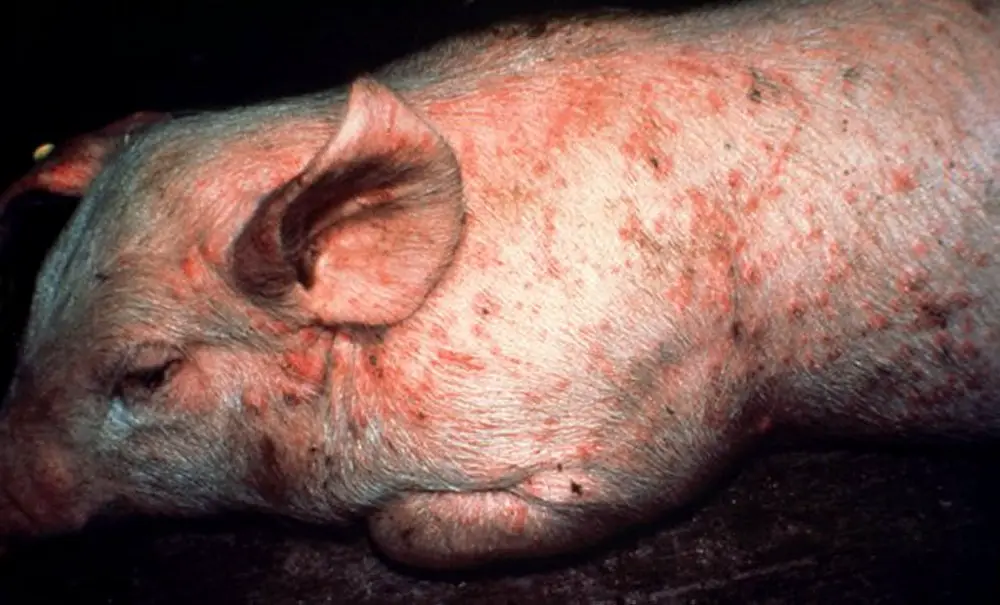Health and safety is always the top priority when deciding to adopt a pet for your home, so it’s important to find out whether pigs carry diseases or not.
Can pigs carry diseases? Pigs can carry diseases that may affect its human owners, as well as the other animals it comes into contact with. This is why it is important to regularly consult with the vet for required vaccinations as well as to maintain a clean environment that will minimize and eliminate potential health risks.
The idea of having a pet at home that carries diseases may be scary. But take note that all kinds of animals could potentially be a disease carrier.

This means that it’s not really a question of whether there are risks or not. It’s more an issue of whether you can really maintain a safe and healthy environment for your pet pig.
Common Diseases Carried by Pigs
When it comes to pig diseases, it would also depend on whether you live on a pig farm, within a hogging area, or in a place where there are no other pigs around. The presence of other animals and wildlife may also affect the spread of diseases.
Here are some common diseases carried by pigs:
- Erysipelas
A form of bacterial infection, erysipelas is characterized by diamond-shaped lesions on the skin that would often be red or black. The pig would also feel a sudden bout of arthritis and would start developing lumps. Sometimes, no symptoms would develop and the pig would just suffer from sudden death.
The bacteria is usually carried by birds and other animals. When their droppings or feces touch the ground, the bacteria could stay there for a few weeks, even months. It can also contaminate water when the bacteria seeps from the dirt and goes into the water source.
Although humans can also get erysipelas, the one found in pigs are a completely different strain.
- Leptospirosis
Another bacterial infection, leptospirosis attacks the host’s genital tract and kidneys. This is one disease that pigs can transfer to humans, and vice versa.
The bacteria is usually spread through urine. Symptoms in pigs mostly concern their ability to breed. Infected pigs may end up with stillborns, as well as with weak piglets.
As for humans, the symptoms include vomiting, headaches, fatigue, and muscle pains.
- Brucellosis
The bacteria-caused brucellosis is spread through pig semen during the process of breeding. It can also be contracted from inhalation or ingestion of the milk, placenta, reproductive fluids, or urine of infected pigs.
In female pigs, there is a risk of abortion and infertility. In male pigs, the symptoms include arthritis, paralysis, and orchitis.
Sadly, there is no vaccination or cure for brucellosis yet. At the moment, depopulation is the only option available for pigs exposed to the disease.
- Pneumonia / Swine Flu
It usually starts with swine flu, then eventually progresses to pneumonia.
Swine flu attacks suddenly, affecting both your pig’s growth rate as well as its appetite. Watch out for signs of rapid breathing, coughing, dehydration, eye discharge, poor circulation, and fever. From there, it may lead to pneumonia where there is a 10% to 15% death rate.
What causes swine flu and pneumonia?
Some of the major causes are poor ventilation, poor hydration, crowded or stuffy environment, and pathogens.
- Swine Pox
Swine pox is a disease exclusive to pigs. It is most common in hogging areas.
Swine pox is caused by a virus that enters a pig’s system through any skin openings like wounds or abrasions. It may also spread when healthy pigs come into contact with any secretion coming from the mouth or nose of infected pigs.
- Foot and Mouth Disease (FMD)
Pigs that have foot and mouth disease would have a noticeable decline in mood and food consumption. They would also have high fevers and would develop small sacs or cysts.
Other than pigs, sheep, goats, water buffalo, deer, bison, and other similar animals can also have FMD.
FMD spreads easily across farms, especially through shared farm equipment.
- Pseudorabies
Despite the name similarities, this is a completely different disease from rabies.
Pigs that have pseudorabies show lesions in the reproductive, respiratory, and nervous systems. It spreads quite easily, but most of the US has been deemed free of this disease.
It is a DNA herpesvirus that spreads through a pig’s saliva, nasal secretions, feces and urine. Some symptoms include high fever, tremors, uncoordination, coughing, sneezing, convulsions, and more.
- Mycoplasma Hyosynoviae
This is a tiny organism that infects a pig’s upper respiratory tract. It is usually seen in growing pigs between 8 to 30 weeks of age.
Pigs infected with this disease would only noticeably stand for short periods of time because of the pain they may feel in the affected area. Pus may also accumulate around the joint areas.
- Salmonellosis
Salmonellosis can cause death in pigs in a matter of days. It is a form of bacterial infection cause by Salmonella in the intestines. It is an illness that a pig can transfer to humans, and vice versa.
Most of the time, the bacteria is transferred through contaminated water, food, or milk.
- Artophic Rhinitis (AR)
AR is very common in pigs, especially in its mild form. It causes damage in the bones in the nose and can distort the snout.
The most common symptoms are sneezing, nose discharge, runny eyes, and signs of facial distortion.
How to Prevent Diseases in Your Pigs
Instead of just lying in wait for potential bad things to happen, make better use of your time by creating an environment that promotes health and prevents disease.
Here are a few practices you should start adopting to help prevent potential diseases from hurting your pet, your home and your family:
- Maintain cleanliness
The more that dirt and clutter accumulate, the higher the chances of you and your pigs getting sick. This is why it’s important to maintain cleanliness around your home at all times.

Make sure your pig’s bedding is fresh and clean all the time. Don’t worry, pigs are actually clean by nature (unlike what we were made to believe our entire lives). They don’t like leaving dirt and urine around the places where they sleep and eat.
However, it is also up to the human to make this possible. If you don’t give your pig enough space to leave their dirt out of their living area, then that’s where the problem starts.
Prioritize training your pig on using the litter box. They’re quick studies, so this shouldn’t be a problem especially if you start training them while they’re young.
Also, make sure you regularly clean the toys they use. Check your entire yard for potential risks as well. Pigs are natural foragers and will dig around. If you’re not careful, they might catch something from the dirt that other wildlife in the area (like birds, rodents, raccoons, etc.) may have left.
- Practice proper hygiene
Always, always, always wash your hands regularly especially if you just handled your pig. Take frequent showers. Just as your pigs are at risk when you leave their bodies and their living areas dirty, you also put yourself and your family at risk when you don’t practice that same level of cleanliness.
- Get the right vaccinations
There are some vaccinations that are required by the state or by your locality. Make sure you follow them all.
There may also be seasonal risks that you have to watch out for. Some diseases are more prevalent in certain seasons, for example. There may also be outbreaks in your area. Make sure you are updated on anything like this.
Your vet would be the best person to consult on what potential risks are present. He may also recommend a few other shots based on your pig’s overall health.
Related Questions
Do pigs carry salmonella?
Pigs that are widely exposed to other animals and to humans may be at risk of contracting salmonella. This bacteria usually spreads in the digestive tract of growing pigs, but they may be present in the intestines of some sows as well. Other animals that may carry this disease are horses, cows, dogs, rabbits and rodents.
Are pet pigs dangerous?
Small pig breeds are generally friendly and easy to train, making them great house pets. They are not at all dangerous, unless they are mistreated and are not cared for the right way. When placed in a thriving environment that promotes their health and happiness, they pose very little risks to both humans and animals around them.
Can pig lice live on humans?
Although there are also lice that are specific to humans, lice found on pigs are completely different and cannot live on humans or any other animal, for that matter. Lice can cause different diseases in pigs, such as swine pox, for example. Pigs usually get lice from other pigs they get into contact with.
